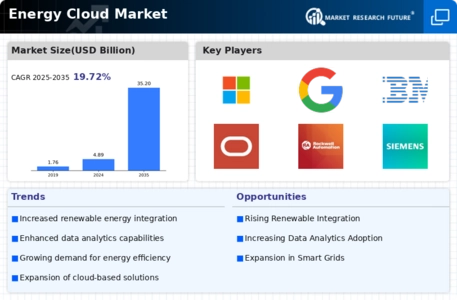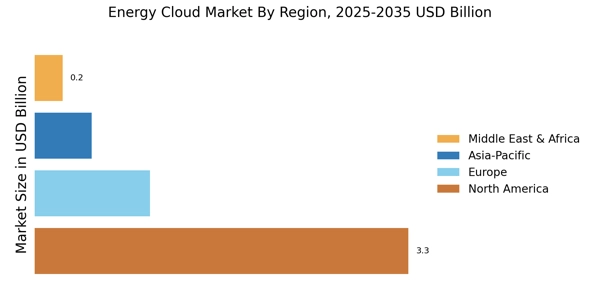Decentralization of Energy Systems
The decentralization of energy systems is a pivotal driver in the Energy Cloud Market. This trend indicates a shift from traditional centralized power generation to localized energy production, such as solar panels and wind turbines. As consumers increasingly adopt distributed energy resources, the demand for energy cloud solutions rises. According to recent data, the share of decentralized energy generation is projected to reach 30% by 2025. This transformation not only enhances energy security but also empowers consumers to manage their energy consumption more effectively. The Energy Cloud Market is thus witnessing a surge in platforms that facilitate the integration and management of these decentralized resources, enabling a more resilient and flexible energy landscape.
Rising Demand for Energy Efficiency
The rising demand for energy efficiency is significantly influencing the Energy Cloud Market. As energy costs continue to escalate, consumers and businesses alike are seeking solutions that minimize energy consumption while maximizing output. Energy cloud platforms provide tools for real-time monitoring and analytics, enabling users to identify inefficiencies and implement corrective measures. Recent studies indicate that energy efficiency measures can reduce energy consumption by up to 30% in commercial buildings. This trend is driving the development of innovative energy management solutions that cater to the needs of various sectors. Consequently, the Energy Cloud Market is poised for growth as organizations increasingly prioritize energy efficiency as a means to reduce operational costs and enhance sustainability.
Integration of Advanced Technologies
The integration of advanced technologies is reshaping the Energy Cloud Market. Innovations such as artificial intelligence, machine learning, and blockchain are being increasingly utilized to optimize energy management and enhance operational efficiency. For instance, AI algorithms can predict energy demand patterns, allowing for better resource allocation. The market for AI in energy management is expected to grow significantly, with estimates suggesting a compound annual growth rate of over 20% through 2025. Furthermore, blockchain technology offers secure and transparent transactions, fostering trust among stakeholders. As these technologies become more prevalent, they are likely to drive the adoption of energy cloud solutions, facilitating a more interconnected and efficient energy ecosystem.
Focus on Sustainability and Compliance
A growing focus on sustainability and compliance is a crucial driver in the Energy Cloud Market. Governments and organizations are increasingly prioritizing renewable energy sources and stringent environmental regulations. This shift is evident in the rising investments in clean energy technologies, which are projected to exceed 1 trillion dollars by 2025. Companies are compelled to adopt energy cloud solutions that not only meet regulatory requirements but also align with corporate sustainability goals. The Energy Cloud Market is responding to this demand by offering platforms that enable organizations to monitor their carbon footprint and optimize energy usage. This alignment with sustainability initiatives is likely to enhance the market's growth as stakeholders seek to balance economic performance with environmental responsibility.
Increased Investment in Renewable Energy
Increased investment in renewable energy sources is a significant driver of the Energy Cloud Market. As the world transitions towards cleaner energy alternatives, substantial capital is being directed towards solar, wind, and other renewable technologies. Reports indicate that investments in renewable energy are expected to surpass 2 trillion dollars by 2025, reflecting a robust commitment to sustainable energy solutions. This influx of capital is fostering innovation within the energy cloud sector, as companies develop platforms that facilitate the integration of renewable resources into existing energy systems. The Energy Cloud Market is thus benefiting from this trend, as stakeholders seek to leverage renewable energy to enhance grid reliability and reduce greenhouse gas emissions.


















Leave a Comment